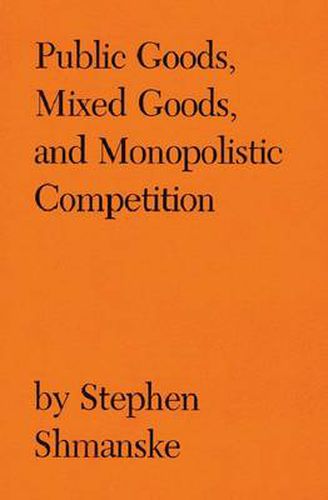Readings Newsletter
Become a Readings Member to make your shopping experience even easier.
Sign in or sign up for free!
You’re not far away from qualifying for FREE standard shipping within Australia
You’ve qualified for FREE standard shipping within Australia
The cart is loading…






Public goods and monopolistic competition have traditionally been separate fields of study in microeconomics, each field having its own array of models. In this book, Stephen Shmanske builds a theoretical bridge between these two areas, suggesting that public goods and monopolistic competition are different dimensional simplifications of the same general model. The author argues first that the generic model for public goods has two dimensions of consumption but that public goods models have usually ignored or simplified the utilization dimension. Furthermore, private goods models in the monopolistic competition vein also have two implicit dimensions of consumption, but again, one of the dimensions is treated in a very constrained fashion. As it turns out, between public goods and monopolistic competition, each model emphasizes the dimension that is ignored or simplified in the other. Thus, the general, mixed goods model draws from both traditions, using the results of one model to generalize and extend the other.
An immediate implication of the analysis is that the traditional models of public goods and monopolistic competition have focused on special cases and thus have provided misleading conclusions. Specifically, monopolistic competition and other models of differentiated oligopoly have reached conclusions in settings that emphasize uniform pricing despite the facts that (1) discriminatory pricing has been studied in competitive situations in public goods models, (2) discriminatory pricing is the more usual pricing method, and (3) the results obtained using uniform pricing do not generalize to more sophisticated pricing regimes. Meanwhile, public goods models have focused on special cases like national defense, where the results obtained do not generally apply in other public or mixed goods settings.
Shmanske’s conclusions have great relevance to policy formation on public goods provision. Public goods and mixed goods are not curious anomalies; they are all around us, and in most cases competitive private sector agents can and have been providing public goods with no market failure. Professionals and scholars in the areas of public finance and industrial organization will appreciate Shmanske’s careful critique of existing models and his rigorous conceptualizing and modeling of public goods in private markets characterized by monopolistic competition.
$9.00 standard shipping within Australia
FREE standard shipping within Australia for orders over $100.00
Express & International shipping calculated at checkout
Public goods and monopolistic competition have traditionally been separate fields of study in microeconomics, each field having its own array of models. In this book, Stephen Shmanske builds a theoretical bridge between these two areas, suggesting that public goods and monopolistic competition are different dimensional simplifications of the same general model. The author argues first that the generic model for public goods has two dimensions of consumption but that public goods models have usually ignored or simplified the utilization dimension. Furthermore, private goods models in the monopolistic competition vein also have two implicit dimensions of consumption, but again, one of the dimensions is treated in a very constrained fashion. As it turns out, between public goods and monopolistic competition, each model emphasizes the dimension that is ignored or simplified in the other. Thus, the general, mixed goods model draws from both traditions, using the results of one model to generalize and extend the other.
An immediate implication of the analysis is that the traditional models of public goods and monopolistic competition have focused on special cases and thus have provided misleading conclusions. Specifically, monopolistic competition and other models of differentiated oligopoly have reached conclusions in settings that emphasize uniform pricing despite the facts that (1) discriminatory pricing has been studied in competitive situations in public goods models, (2) discriminatory pricing is the more usual pricing method, and (3) the results obtained using uniform pricing do not generalize to more sophisticated pricing regimes. Meanwhile, public goods models have focused on special cases like national defense, where the results obtained do not generally apply in other public or mixed goods settings.
Shmanske’s conclusions have great relevance to policy formation on public goods provision. Public goods and mixed goods are not curious anomalies; they are all around us, and in most cases competitive private sector agents can and have been providing public goods with no market failure. Professionals and scholars in the areas of public finance and industrial organization will appreciate Shmanske’s careful critique of existing models and his rigorous conceptualizing and modeling of public goods in private markets characterized by monopolistic competition.